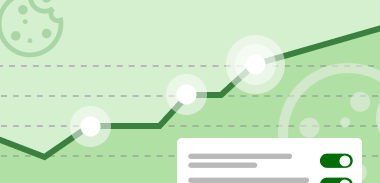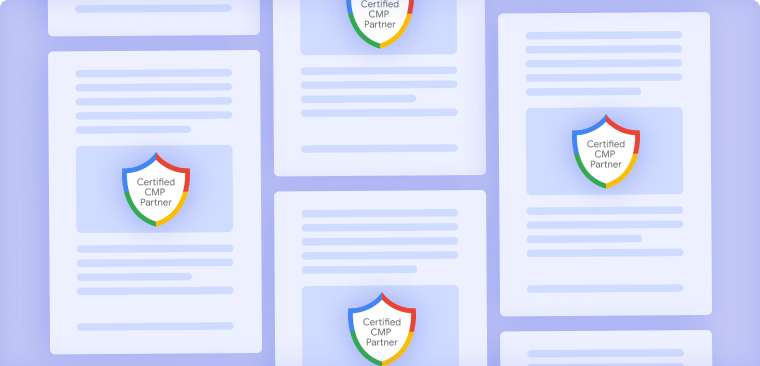CMPs and Dark Patterns: What Not to Do in Your Consent Design
November 07, 2025
•
3 min read
Table of contents
back
to the top
CMPs and Dark Patterns: What Not to Do in Your Consent Design
Consent Management Platforms (CMPs) are supposed to help websites stay GDPR-compliant but not all CMPs play fair. Some use dark patterns that trick users into giving consent they might not have freely chosen. While these deceptive UX tactics might boost short-term opt-in rates, they carry long-term legal and reputational risks under the GDPR.
This blog breaks down what dark patterns in consent design look like, why they're non-compliant, and how to avoid them by taking an ethical, transparent approach.
What Are Dark Patterns in CMPs?
Dark patterns are design choices that manipulate users into making decisions they wouldn't have otherwise made often by confusing, rushing, or limiting their options.
In the context of GDPR and cookie banners, dark patterns include:
-
Making the "Accept All" button bigger or more colorful than the
"Reject All" button
-
Hiding or obscuring cookie settings
-
Pre-ticking consent checkboxes
-
Using misleading language ("Continue" instead of "Accept")
-
Making opting out difficult or multi-step
These tactics don't just undermine user trust, they violate the GDPR's requirement for freely given, informed, and unambiguous consent.
GDPR on Dark Patterns: What the Law Says
The European Data Protection Board (EDPB) and several Data Protection Authorities (like CNIL and the UK ICO) have made it clear: dark patterns are not compliant.
Key GDPR principles violated by dark patterns include:
-
Transparency (Art. 5.1(a)) - Users must clearly understand what
they're consenting to
-
Freely Given Consent (Art. 7) - Consent must be a real choice,
not manipulated
-
Unambiguous Indication (Recital 32) - Silence, pre-ticked boxes,
or inactivity do not constitute consent
Using deceptive consent UX could lead to:
- Regulatory fines
- Enforced redesigns
- Damaged brand reputation
What Ethical Consent Design Looks Like
An ethical CMP, like Cookiepal, follows GDPR best practices by:
-
Giving equal weight and visibility to "Accept" and "Reject" options
-
Avoiding any pre-ticked boxes
-
Offering clear, jargon-free explanations of each cookie type
-
Making it easy to revisit or change consent choices
-
Supporting granular consent so users can pick and choose what they
agree to
This approach builds trust, improves user experience, and keeps your business audit-ready.
Why Shady Consent UX Is a Legal Risk
In recent years, regulators have cracked down on dark patterns:
-
CNIL fined Google €100M for making it harder to reject cookies
than accept them
-
The Danish DPA ordered companies to redesign banners that lacked
balance
-
NOYB complaints target websites with misleading UX --- often
using CMPs that allow it
The message is clear: compliance isn't just about having a CMP, it's about how you use it.
Final Takeaway
Dark patterns may boost short-term consent rates, but they're a liability under the GDPR. A responsible CMP should empower users to make informed, fair choices not manipulate them.
Cookiepal helps you stay on the right side of both the law and your users, with transparent, ethical, and fully GDPR-compliant consent flows.
Sources
EDPB Guidelines on Consent
https://edpb.europa.eu/our-work-tools/our-documents/guidelines/guidelines-052020-consent-under-regulation-2016679_en
CNIL Recommendations on Cookies**-** https://www.cnil.fr/en/cookies-and-other-tracking-devices
NOYB Dark Pattern Complaints- https://noyb.eu/en
Explore further

Cookiepal vs Free Cookie Banners: Why Compliance Costs Less Than Fines
Cookiepal vs free banners: why paid CMPs save you money, reduce legal risk, and boost trust—free plugins often lack GDPR compliance, logs, and consent controls.
November 13, 2025
2 min

Optimizing Consent Rates Without Violating GDPR
Want to boost consent rates without breaking GDPR rules? Many teams cut corners, but there’s a better way — increase opt-ins legally and effectively.
May 12, 2025
3 min

How Google's Consent Mode v2 Impacts Your Data Collection
Using Google Ads or Analytics in the EU? Consent Mode v2 now limits data collection without proper GDPR-compliant consent. Here's what it means and how to stay compliant.
May 01, 2025
4 min



